Child Protection Laws and Systems in Ebony's Tragic Death Case Study
VerifiedAdded on 2022/09/26
|9
|2946
|19
Case Study
AI Summary
This case study examines the tragic death of Ebony in 2007, focusing on the adequacy of child protection laws and systems in New South Wales, Australia. The assignment begins with an introduction to child protection laws, their importance, and the context of Ebony's death. It then delves into the background of the case, detailing the circumstances surrounding Ebony's death from starvation and neglect, the subsequent legal proceedings, and the establishment of the Wood Inquiry. The core of the analysis evaluates whether the existing child protection laws and systems were sufficient, highlighting failures such as the lack of proper investigation and intervention by relevant authorities. The study also explores the findings and recommendations of the Wood Inquiry, which aimed to address the shortcomings in child protection services. The conclusion emphasizes the significance of effective child protection laws and systems and the need for accountability to prevent similar tragedies. The assignment utilizes academic sources to support its arguments and analysis.
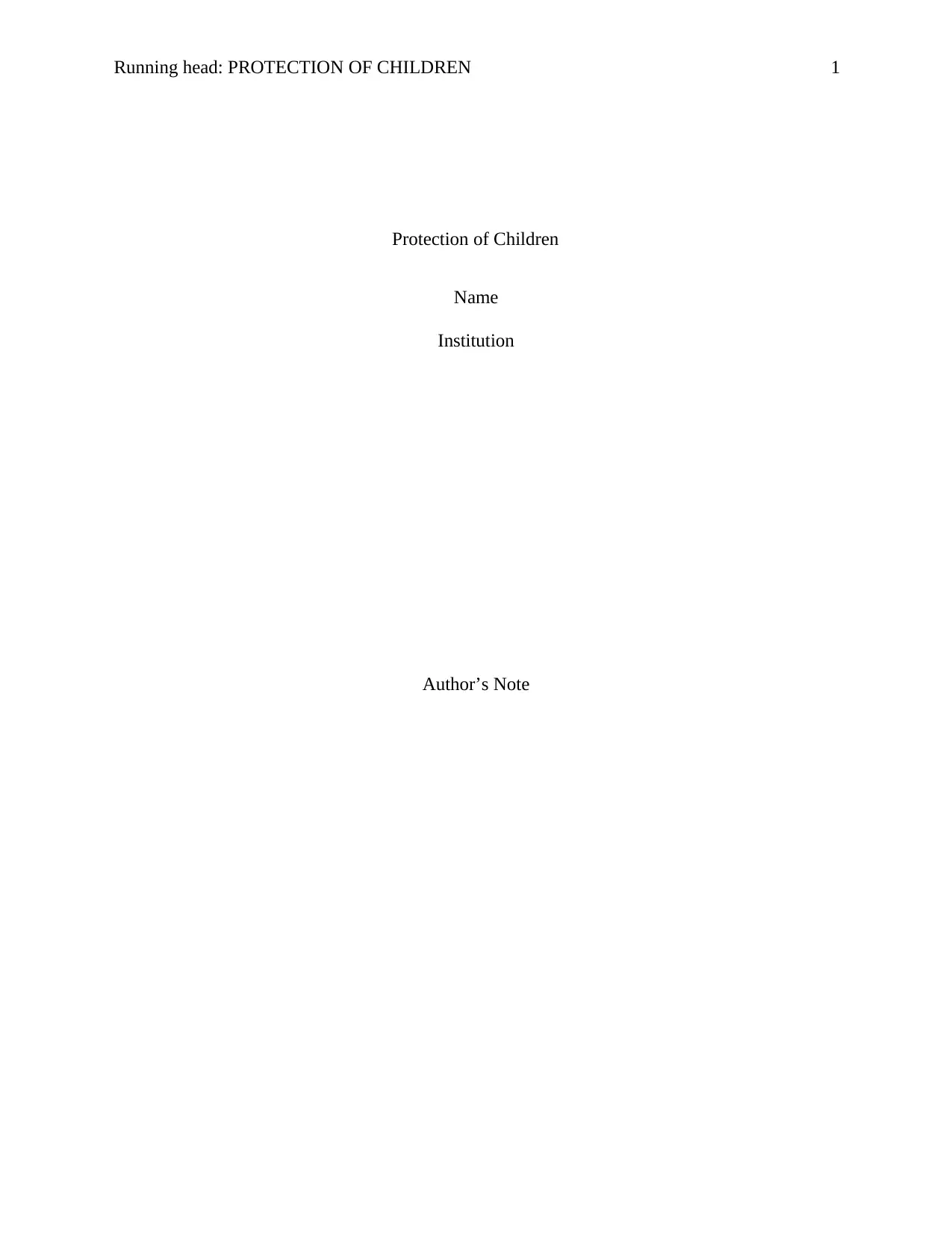
Running head: PROTECTION OF CHILDREN 1
Protection of Children
Name
Institution
Author’s Note
Protection of Children
Name
Institution
Author’s Note
Paraphrase This Document
Need a fresh take? Get an instant paraphrase of this document with our AI Paraphraser
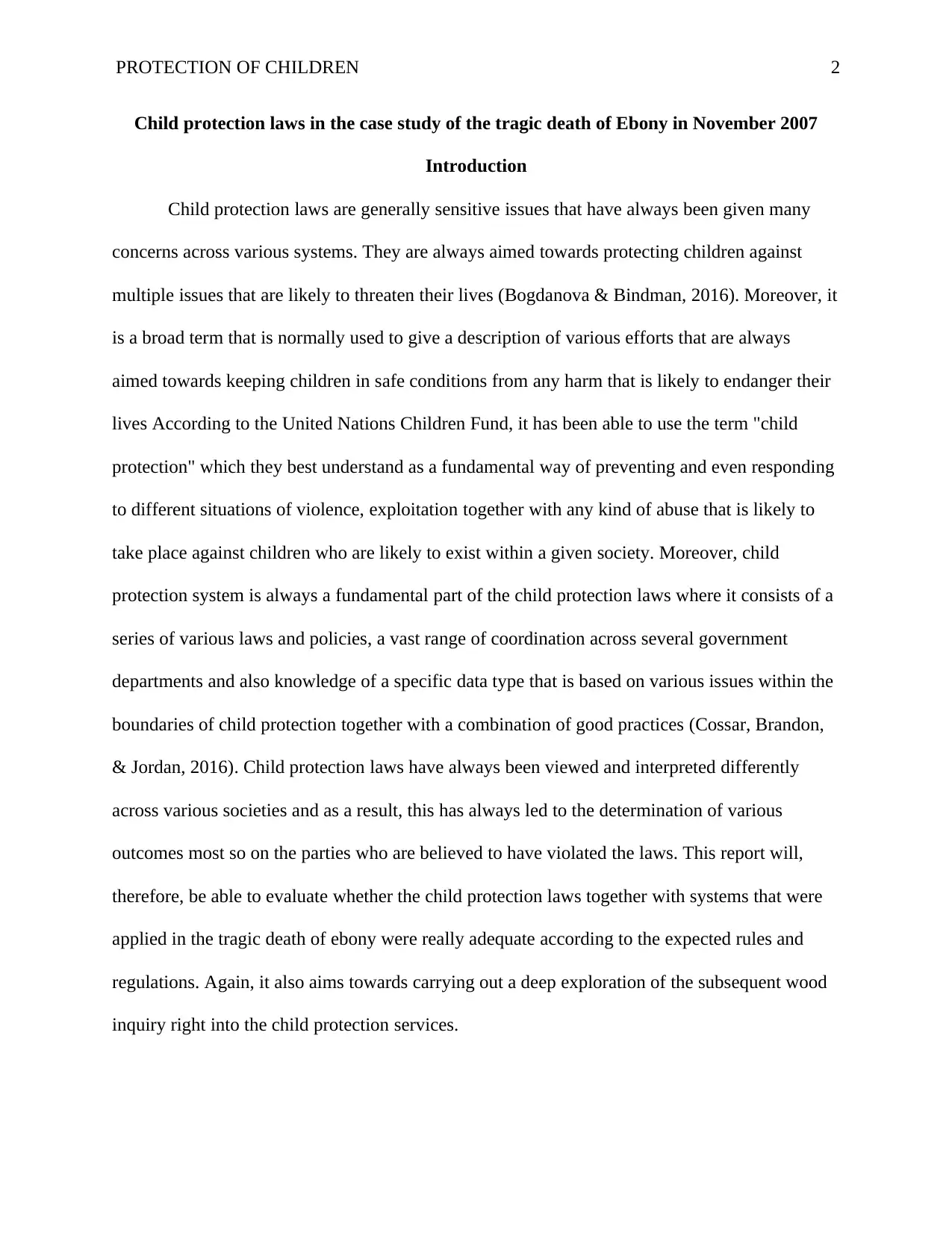
PROTECTION OF CHILDREN 2
Child protection laws in the case study of the tragic death of Ebony in November 2007
Introduction
Child protection laws are generally sensitive issues that have always been given many
concerns across various systems. They are always aimed towards protecting children against
multiple issues that are likely to threaten their lives (Bogdanova & Bindman, 2016). Moreover, it
is a broad term that is normally used to give a description of various efforts that are always
aimed towards keeping children in safe conditions from any harm that is likely to endanger their
lives According to the United Nations Children Fund, it has been able to use the term "child
protection" which they best understand as a fundamental way of preventing and even responding
to different situations of violence, exploitation together with any kind of abuse that is likely to
take place against children who are likely to exist within a given society. Moreover, child
protection system is always a fundamental part of the child protection laws where it consists of a
series of various laws and policies, a vast range of coordination across several government
departments and also knowledge of a specific data type that is based on various issues within the
boundaries of child protection together with a combination of good practices (Cossar, Brandon,
& Jordan, 2016). Child protection laws have always been viewed and interpreted differently
across various societies and as a result, this has always led to the determination of various
outcomes most so on the parties who are believed to have violated the laws. This report will,
therefore, be able to evaluate whether the child protection laws together with systems that were
applied in the tragic death of ebony were really adequate according to the expected rules and
regulations. Again, it also aims towards carrying out a deep exploration of the subsequent wood
inquiry right into the child protection services.
Child protection laws in the case study of the tragic death of Ebony in November 2007
Introduction
Child protection laws are generally sensitive issues that have always been given many
concerns across various systems. They are always aimed towards protecting children against
multiple issues that are likely to threaten their lives (Bogdanova & Bindman, 2016). Moreover, it
is a broad term that is normally used to give a description of various efforts that are always
aimed towards keeping children in safe conditions from any harm that is likely to endanger their
lives According to the United Nations Children Fund, it has been able to use the term "child
protection" which they best understand as a fundamental way of preventing and even responding
to different situations of violence, exploitation together with any kind of abuse that is likely to
take place against children who are likely to exist within a given society. Moreover, child
protection system is always a fundamental part of the child protection laws where it consists of a
series of various laws and policies, a vast range of coordination across several government
departments and also knowledge of a specific data type that is based on various issues within the
boundaries of child protection together with a combination of good practices (Cossar, Brandon,
& Jordan, 2016). Child protection laws have always been viewed and interpreted differently
across various societies and as a result, this has always led to the determination of various
outcomes most so on the parties who are believed to have violated the laws. This report will,
therefore, be able to evaluate whether the child protection laws together with systems that were
applied in the tragic death of ebony were really adequate according to the expected rules and
regulations. Again, it also aims towards carrying out a deep exploration of the subsequent wood
inquiry right into the child protection services.
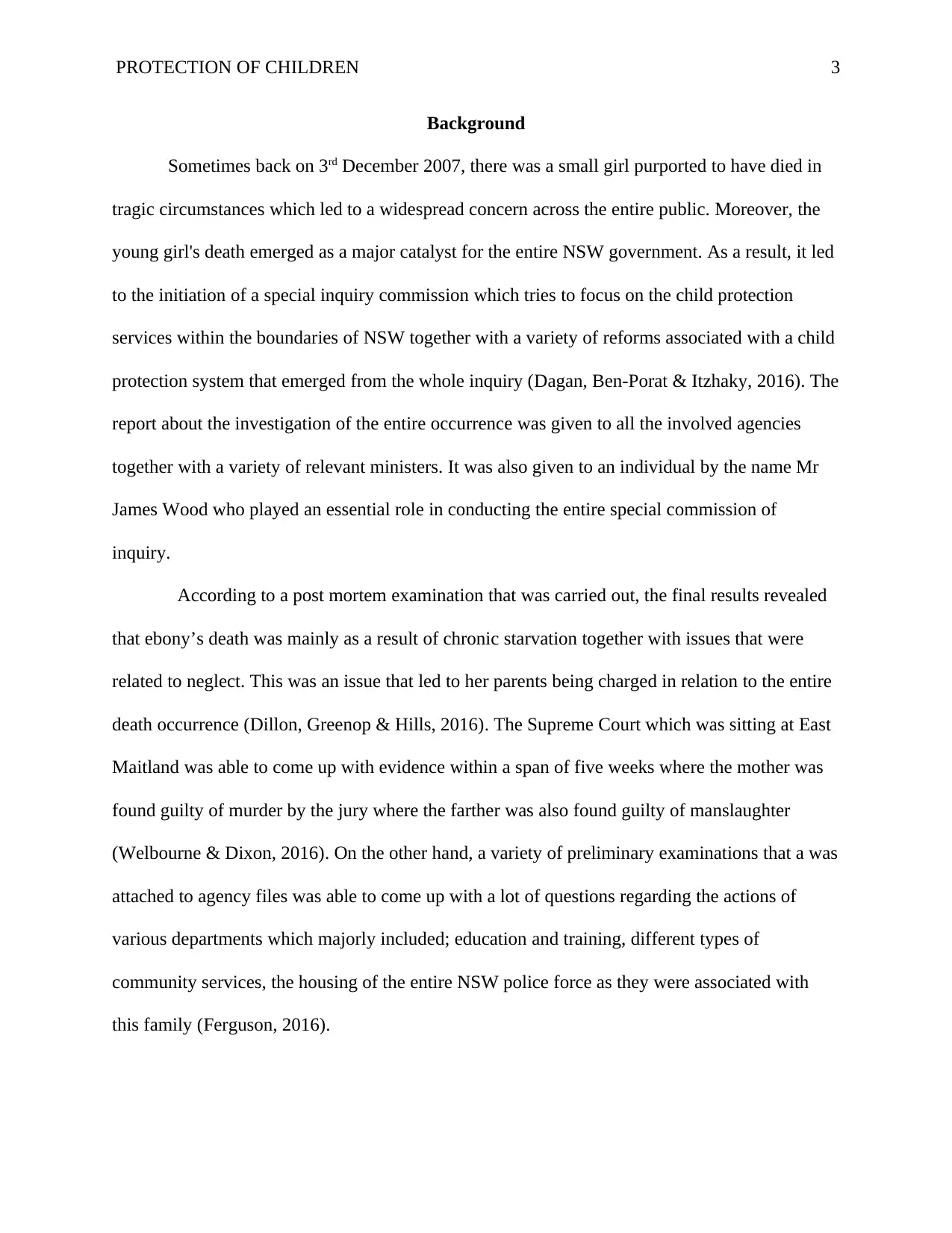
PROTECTION OF CHILDREN 3
Background
Sometimes back on 3rd December 2007, there was a small girl purported to have died in
tragic circumstances which led to a widespread concern across the entire public. Moreover, the
young girl's death emerged as a major catalyst for the entire NSW government. As a result, it led
to the initiation of a special inquiry commission which tries to focus on the child protection
services within the boundaries of NSW together with a variety of reforms associated with a child
protection system that emerged from the whole inquiry (Dagan, Ben-Porat & Itzhaky, 2016). The
report about the investigation of the entire occurrence was given to all the involved agencies
together with a variety of relevant ministers. It was also given to an individual by the name Mr
James Wood who played an essential role in conducting the entire special commission of
inquiry.
According to a post mortem examination that was carried out, the final results revealed
that ebony’s death was mainly as a result of chronic starvation together with issues that were
related to neglect. This was an issue that led to her parents being charged in relation to the entire
death occurrence (Dillon, Greenop & Hills, 2016). The Supreme Court which was sitting at East
Maitland was able to come up with evidence within a span of five weeks where the mother was
found guilty of murder by the jury where the farther was also found guilty of manslaughter
(Welbourne & Dixon, 2016). On the other hand, a variety of preliminary examinations that a was
attached to agency files was able to come up with a lot of questions regarding the actions of
various departments which majorly included; education and training, different types of
community services, the housing of the entire NSW police force as they were associated with
this family (Ferguson, 2016).
Background
Sometimes back on 3rd December 2007, there was a small girl purported to have died in
tragic circumstances which led to a widespread concern across the entire public. Moreover, the
young girl's death emerged as a major catalyst for the entire NSW government. As a result, it led
to the initiation of a special inquiry commission which tries to focus on the child protection
services within the boundaries of NSW together with a variety of reforms associated with a child
protection system that emerged from the whole inquiry (Dagan, Ben-Porat & Itzhaky, 2016). The
report about the investigation of the entire occurrence was given to all the involved agencies
together with a variety of relevant ministers. It was also given to an individual by the name Mr
James Wood who played an essential role in conducting the entire special commission of
inquiry.
According to a post mortem examination that was carried out, the final results revealed
that ebony’s death was mainly as a result of chronic starvation together with issues that were
related to neglect. This was an issue that led to her parents being charged in relation to the entire
death occurrence (Dillon, Greenop & Hills, 2016). The Supreme Court which was sitting at East
Maitland was able to come up with evidence within a span of five weeks where the mother was
found guilty of murder by the jury where the farther was also found guilty of manslaughter
(Welbourne & Dixon, 2016). On the other hand, a variety of preliminary examinations that a was
attached to agency files was able to come up with a lot of questions regarding the actions of
various departments which majorly included; education and training, different types of
community services, the housing of the entire NSW police force as they were associated with
this family (Ferguson, 2016).
⊘ This is a preview!⊘
Do you want full access?
Subscribe today to unlock all pages.

Trusted by 1+ million students worldwide
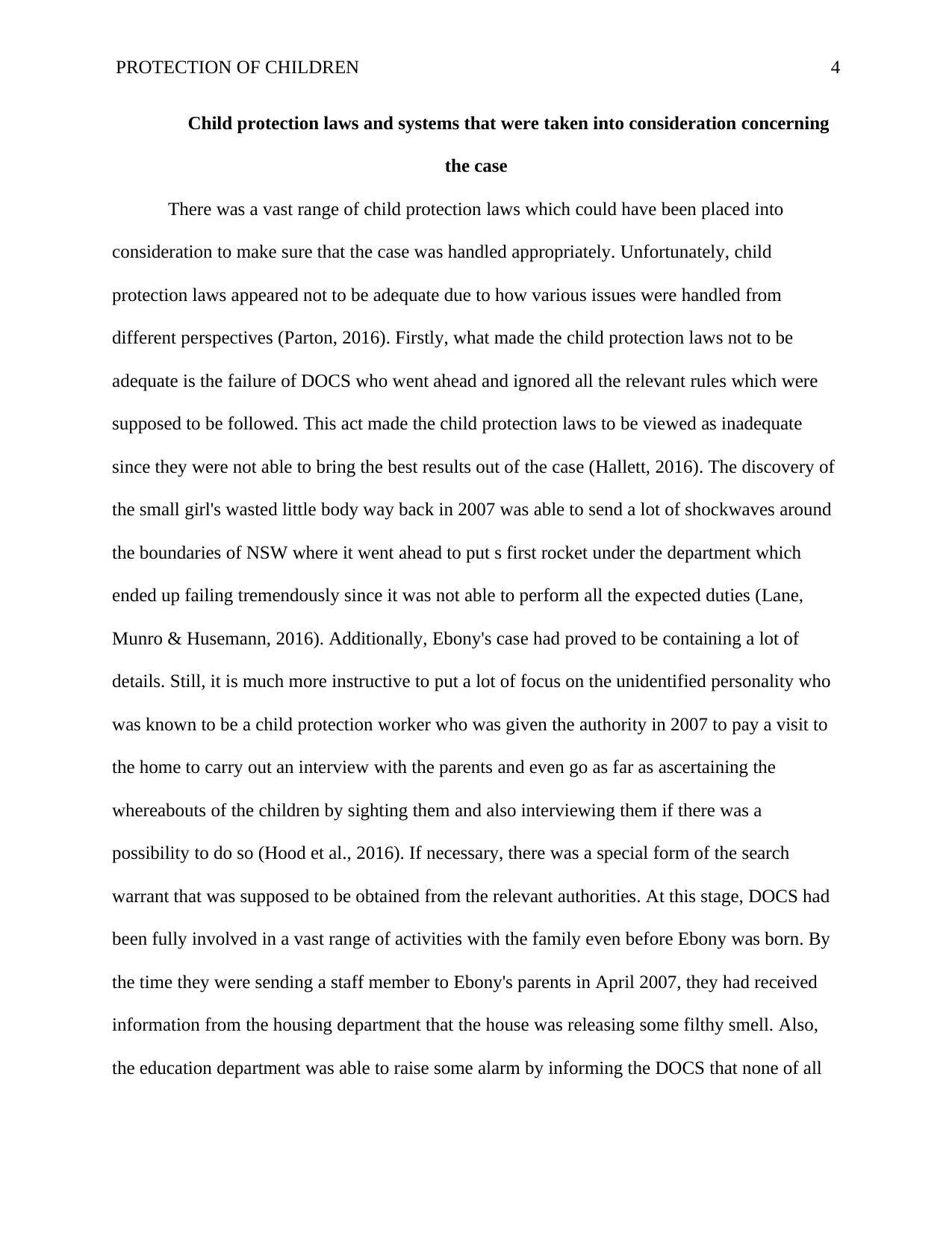
PROTECTION OF CHILDREN 4
Child protection laws and systems that were taken into consideration concerning
the case
There was a vast range of child protection laws which could have been placed into
consideration to make sure that the case was handled appropriately. Unfortunately, child
protection laws appeared not to be adequate due to how various issues were handled from
different perspectives (Parton, 2016). Firstly, what made the child protection laws not to be
adequate is the failure of DOCS who went ahead and ignored all the relevant rules which were
supposed to be followed. This act made the child protection laws to be viewed as inadequate
since they were not able to bring the best results out of the case (Hallett, 2016). The discovery of
the small girl's wasted little body way back in 2007 was able to send a lot of shockwaves around
the boundaries of NSW where it went ahead to put s first rocket under the department which
ended up failing tremendously since it was not able to perform all the expected duties (Lane,
Munro & Husemann, 2016). Additionally, Ebony's case had proved to be containing a lot of
details. Still, it is much more instructive to put a lot of focus on the unidentified personality who
was known to be a child protection worker who was given the authority in 2007 to pay a visit to
the home to carry out an interview with the parents and even go as far as ascertaining the
whereabouts of the children by sighting them and also interviewing them if there was a
possibility to do so (Hood et al., 2016). If necessary, there was a special form of the search
warrant that was supposed to be obtained from the relevant authorities. At this stage, DOCS had
been fully involved in a vast range of activities with the family even before Ebony was born. By
the time they were sending a staff member to Ebony's parents in April 2007, they had received
information from the housing department that the house was releasing some filthy smell. Also,
the education department was able to raise some alarm by informing the DOCS that none of all
Child protection laws and systems that were taken into consideration concerning
the case
There was a vast range of child protection laws which could have been placed into
consideration to make sure that the case was handled appropriately. Unfortunately, child
protection laws appeared not to be adequate due to how various issues were handled from
different perspectives (Parton, 2016). Firstly, what made the child protection laws not to be
adequate is the failure of DOCS who went ahead and ignored all the relevant rules which were
supposed to be followed. This act made the child protection laws to be viewed as inadequate
since they were not able to bring the best results out of the case (Hallett, 2016). The discovery of
the small girl's wasted little body way back in 2007 was able to send a lot of shockwaves around
the boundaries of NSW where it went ahead to put s first rocket under the department which
ended up failing tremendously since it was not able to perform all the expected duties (Lane,
Munro & Husemann, 2016). Additionally, Ebony's case had proved to be containing a lot of
details. Still, it is much more instructive to put a lot of focus on the unidentified personality who
was known to be a child protection worker who was given the authority in 2007 to pay a visit to
the home to carry out an interview with the parents and even go as far as ascertaining the
whereabouts of the children by sighting them and also interviewing them if there was a
possibility to do so (Hood et al., 2016). If necessary, there was a special form of the search
warrant that was supposed to be obtained from the relevant authorities. At this stage, DOCS had
been fully involved in a vast range of activities with the family even before Ebony was born. By
the time they were sending a staff member to Ebony's parents in April 2007, they had received
information from the housing department that the house was releasing some filthy smell. Also,
the education department was able to raise some alarm by informing the DOCS that none of all
Paraphrase This Document
Need a fresh take? Get an instant paraphrase of this document with our AI Paraphraser
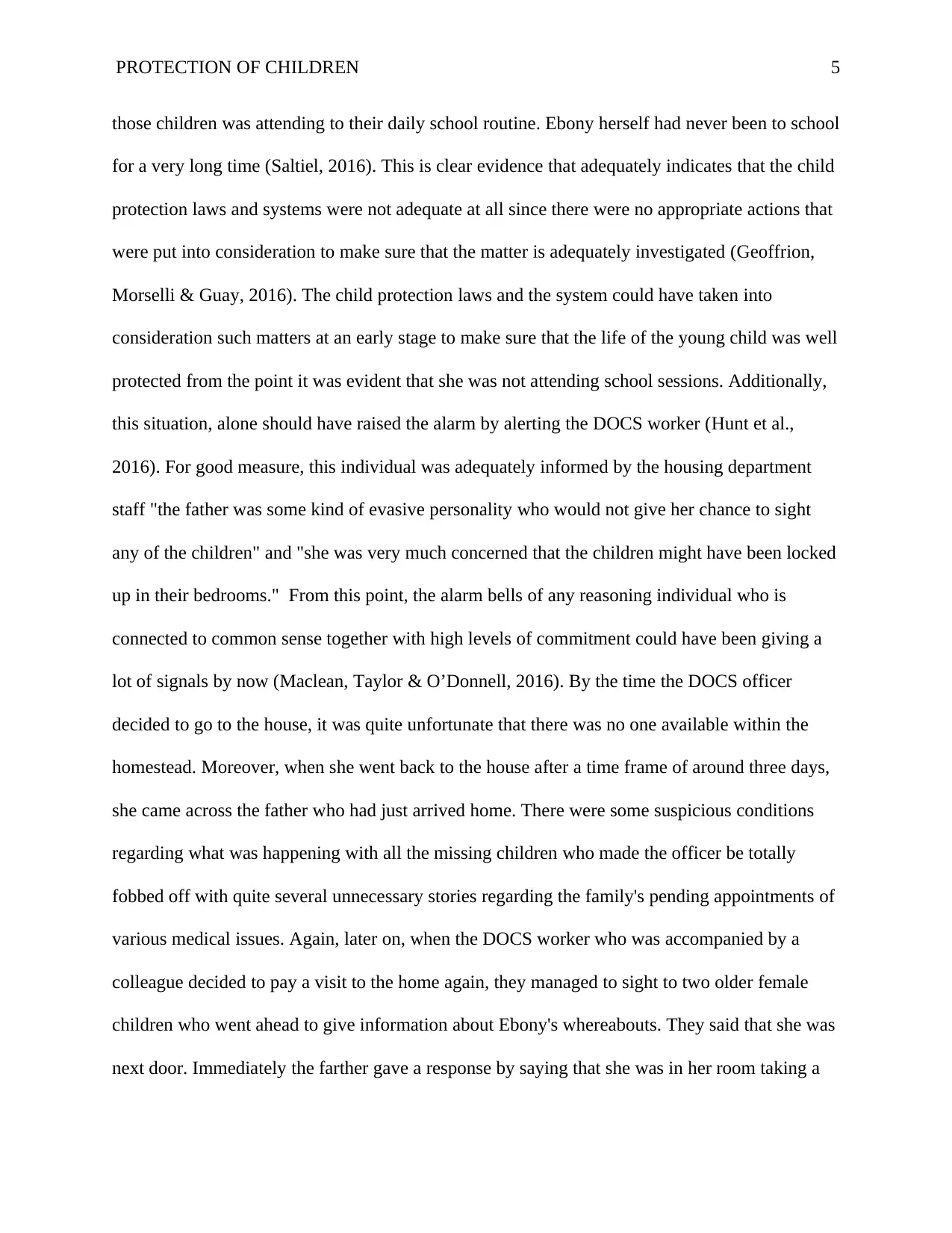
PROTECTION OF CHILDREN 5
those children was attending to their daily school routine. Ebony herself had never been to school
for a very long time (Saltiel, 2016). This is clear evidence that adequately indicates that the child
protection laws and systems were not adequate at all since there were no appropriate actions that
were put into consideration to make sure that the matter is adequately investigated (Geoffrion,
Morselli & Guay, 2016). The child protection laws and the system could have taken into
consideration such matters at an early stage to make sure that the life of the young child was well
protected from the point it was evident that she was not attending school sessions. Additionally,
this situation, alone should have raised the alarm by alerting the DOCS worker (Hunt et al.,
2016). For good measure, this individual was adequately informed by the housing department
staff "the father was some kind of evasive personality who would not give her chance to sight
any of the children" and "she was very much concerned that the children might have been locked
up in their bedrooms." From this point, the alarm bells of any reasoning individual who is
connected to common sense together with high levels of commitment could have been giving a
lot of signals by now (Maclean, Taylor & O’Donnell, 2016). By the time the DOCS officer
decided to go to the house, it was quite unfortunate that there was no one available within the
homestead. Moreover, when she went back to the house after a time frame of around three days,
she came across the father who had just arrived home. There were some suspicious conditions
regarding what was happening with all the missing children who made the officer be totally
fobbed off with quite several unnecessary stories regarding the family's pending appointments of
various medical issues. Again, later on, when the DOCS worker who was accompanied by a
colleague decided to pay a visit to the home again, they managed to sight to two older female
children who went ahead to give information about Ebony's whereabouts. They said that she was
next door. Immediately the farther gave a response by saying that she was in her room taking a
those children was attending to their daily school routine. Ebony herself had never been to school
for a very long time (Saltiel, 2016). This is clear evidence that adequately indicates that the child
protection laws and systems were not adequate at all since there were no appropriate actions that
were put into consideration to make sure that the matter is adequately investigated (Geoffrion,
Morselli & Guay, 2016). The child protection laws and the system could have taken into
consideration such matters at an early stage to make sure that the life of the young child was well
protected from the point it was evident that she was not attending school sessions. Additionally,
this situation, alone should have raised the alarm by alerting the DOCS worker (Hunt et al.,
2016). For good measure, this individual was adequately informed by the housing department
staff "the father was some kind of evasive personality who would not give her chance to sight
any of the children" and "she was very much concerned that the children might have been locked
up in their bedrooms." From this point, the alarm bells of any reasoning individual who is
connected to common sense together with high levels of commitment could have been giving a
lot of signals by now (Maclean, Taylor & O’Donnell, 2016). By the time the DOCS officer
decided to go to the house, it was quite unfortunate that there was no one available within the
homestead. Moreover, when she went back to the house after a time frame of around three days,
she came across the father who had just arrived home. There were some suspicious conditions
regarding what was happening with all the missing children who made the officer be totally
fobbed off with quite several unnecessary stories regarding the family's pending appointments of
various medical issues. Again, later on, when the DOCS worker who was accompanied by a
colleague decided to pay a visit to the home again, they managed to sight to two older female
children who went ahead to give information about Ebony's whereabouts. They said that she was
next door. Immediately the farther gave a response by saying that she was in her room taking a
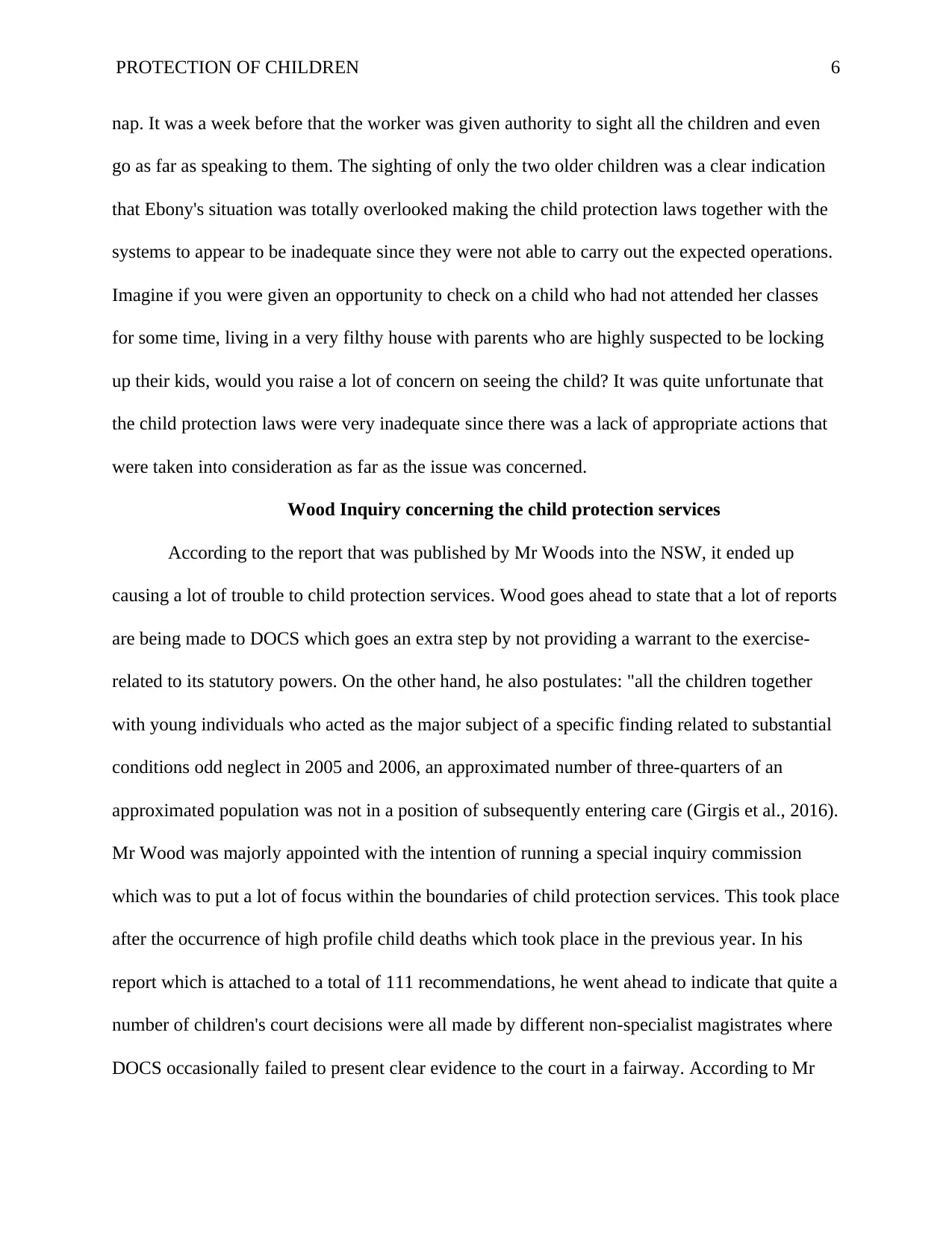
PROTECTION OF CHILDREN 6
nap. It was a week before that the worker was given authority to sight all the children and even
go as far as speaking to them. The sighting of only the two older children was a clear indication
that Ebony's situation was totally overlooked making the child protection laws together with the
systems to appear to be inadequate since they were not able to carry out the expected operations.
Imagine if you were given an opportunity to check on a child who had not attended her classes
for some time, living in a very filthy house with parents who are highly suspected to be locking
up their kids, would you raise a lot of concern on seeing the child? It was quite unfortunate that
the child protection laws were very inadequate since there was a lack of appropriate actions that
were taken into consideration as far as the issue was concerned.
Wood Inquiry concerning the child protection services
According to the report that was published by Mr Woods into the NSW, it ended up
causing a lot of trouble to child protection services. Wood goes ahead to state that a lot of reports
are being made to DOCS which goes an extra step by not providing a warrant to the exercise-
related to its statutory powers. On the other hand, he also postulates: "all the children together
with young individuals who acted as the major subject of a specific finding related to substantial
conditions odd neglect in 2005 and 2006, an approximated number of three-quarters of an
approximated population was not in a position of subsequently entering care (Girgis et al., 2016).
Mr Wood was majorly appointed with the intention of running a special inquiry commission
which was to put a lot of focus within the boundaries of child protection services. This took place
after the occurrence of high profile child deaths which took place in the previous year. In his
report which is attached to a total of 111 recommendations, he went ahead to indicate that quite a
number of children's court decisions were all made by different non-specialist magistrates where
DOCS occasionally failed to present clear evidence to the court in a fairway. According to Mr
nap. It was a week before that the worker was given authority to sight all the children and even
go as far as speaking to them. The sighting of only the two older children was a clear indication
that Ebony's situation was totally overlooked making the child protection laws together with the
systems to appear to be inadequate since they were not able to carry out the expected operations.
Imagine if you were given an opportunity to check on a child who had not attended her classes
for some time, living in a very filthy house with parents who are highly suspected to be locking
up their kids, would you raise a lot of concern on seeing the child? It was quite unfortunate that
the child protection laws were very inadequate since there was a lack of appropriate actions that
were taken into consideration as far as the issue was concerned.
Wood Inquiry concerning the child protection services
According to the report that was published by Mr Woods into the NSW, it ended up
causing a lot of trouble to child protection services. Wood goes ahead to state that a lot of reports
are being made to DOCS which goes an extra step by not providing a warrant to the exercise-
related to its statutory powers. On the other hand, he also postulates: "all the children together
with young individuals who acted as the major subject of a specific finding related to substantial
conditions odd neglect in 2005 and 2006, an approximated number of three-quarters of an
approximated population was not in a position of subsequently entering care (Girgis et al., 2016).
Mr Wood was majorly appointed with the intention of running a special inquiry commission
which was to put a lot of focus within the boundaries of child protection services. This took place
after the occurrence of high profile child deaths which took place in the previous year. In his
report which is attached to a total of 111 recommendations, he went ahead to indicate that quite a
number of children's court decisions were all made by different non-specialist magistrates where
DOCS occasionally failed to present clear evidence to the court in a fairway. According to Mr
⊘ This is a preview!⊘
Do you want full access?
Subscribe today to unlock all pages.

Trusted by 1+ million students worldwide
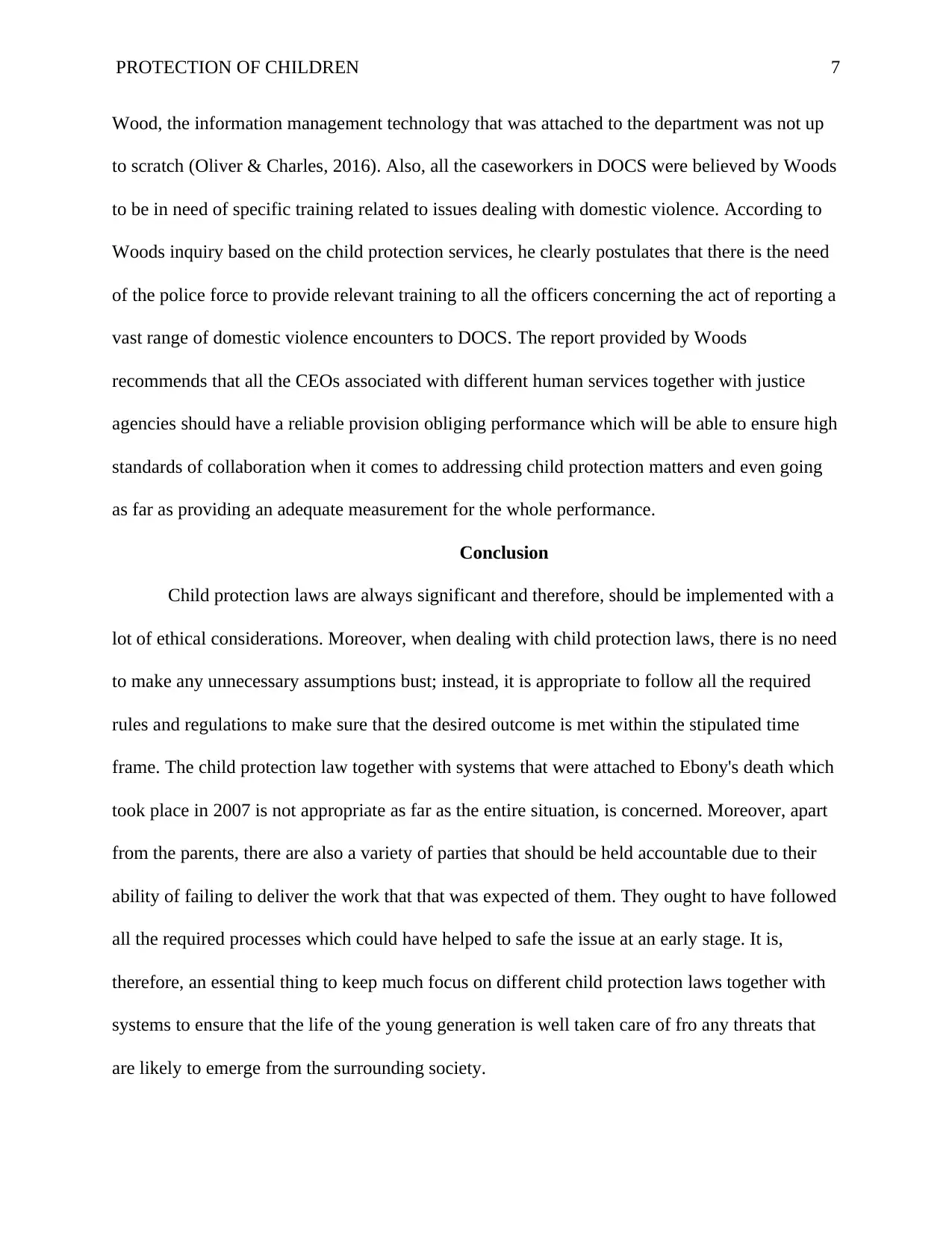
PROTECTION OF CHILDREN 7
Wood, the information management technology that was attached to the department was not up
to scratch (Oliver & Charles, 2016). Also, all the caseworkers in DOCS were believed by Woods
to be in need of specific training related to issues dealing with domestic violence. According to
Woods inquiry based on the child protection services, he clearly postulates that there is the need
of the police force to provide relevant training to all the officers concerning the act of reporting a
vast range of domestic violence encounters to DOCS. The report provided by Woods
recommends that all the CEOs associated with different human services together with justice
agencies should have a reliable provision obliging performance which will be able to ensure high
standards of collaboration when it comes to addressing child protection matters and even going
as far as providing an adequate measurement for the whole performance.
Conclusion
Child protection laws are always significant and therefore, should be implemented with a
lot of ethical considerations. Moreover, when dealing with child protection laws, there is no need
to make any unnecessary assumptions bust; instead, it is appropriate to follow all the required
rules and regulations to make sure that the desired outcome is met within the stipulated time
frame. The child protection law together with systems that were attached to Ebony's death which
took place in 2007 is not appropriate as far as the entire situation, is concerned. Moreover, apart
from the parents, there are also a variety of parties that should be held accountable due to their
ability of failing to deliver the work that that was expected of them. They ought to have followed
all the required processes which could have helped to safe the issue at an early stage. It is,
therefore, an essential thing to keep much focus on different child protection laws together with
systems to ensure that the life of the young generation is well taken care of fro any threats that
are likely to emerge from the surrounding society.
Wood, the information management technology that was attached to the department was not up
to scratch (Oliver & Charles, 2016). Also, all the caseworkers in DOCS were believed by Woods
to be in need of specific training related to issues dealing with domestic violence. According to
Woods inquiry based on the child protection services, he clearly postulates that there is the need
of the police force to provide relevant training to all the officers concerning the act of reporting a
vast range of domestic violence encounters to DOCS. The report provided by Woods
recommends that all the CEOs associated with different human services together with justice
agencies should have a reliable provision obliging performance which will be able to ensure high
standards of collaboration when it comes to addressing child protection matters and even going
as far as providing an adequate measurement for the whole performance.
Conclusion
Child protection laws are always significant and therefore, should be implemented with a
lot of ethical considerations. Moreover, when dealing with child protection laws, there is no need
to make any unnecessary assumptions bust; instead, it is appropriate to follow all the required
rules and regulations to make sure that the desired outcome is met within the stipulated time
frame. The child protection law together with systems that were attached to Ebony's death which
took place in 2007 is not appropriate as far as the entire situation, is concerned. Moreover, apart
from the parents, there are also a variety of parties that should be held accountable due to their
ability of failing to deliver the work that that was expected of them. They ought to have followed
all the required processes which could have helped to safe the issue at an early stage. It is,
therefore, an essential thing to keep much focus on different child protection laws together with
systems to ensure that the life of the young generation is well taken care of fro any threats that
are likely to emerge from the surrounding society.
Paraphrase This Document
Need a fresh take? Get an instant paraphrase of this document with our AI Paraphraser
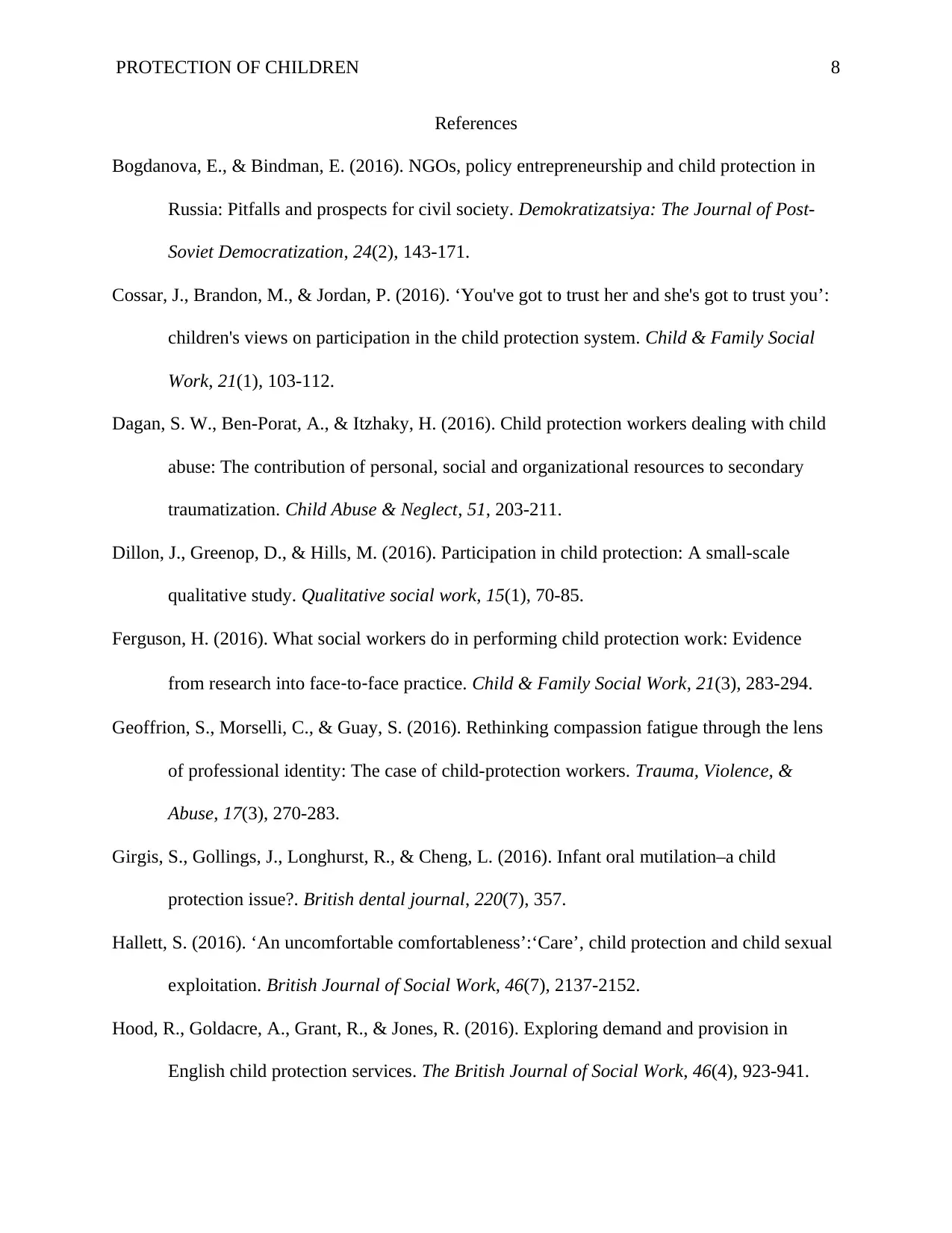
PROTECTION OF CHILDREN 8
References
Bogdanova, E., & Bindman, E. (2016). NGOs, policy entrepreneurship and child protection in
Russia: Pitfalls and prospects for civil society. Demokratizatsiya: The Journal of Post-
Soviet Democratization, 24(2), 143-171.
Cossar, J., Brandon, M., & Jordan, P. (2016). ‘You've got to trust her and she's got to trust you’:
children's views on participation in the child protection system. Child & Family Social
Work, 21(1), 103-112.
Dagan, S. W., Ben-Porat, A., & Itzhaky, H. (2016). Child protection workers dealing with child
abuse: The contribution of personal, social and organizational resources to secondary
traumatization. Child Abuse & Neglect, 51, 203-211.
Dillon, J., Greenop, D., & Hills, M. (2016). Participation in child protection: A small-scale
qualitative study. Qualitative social work, 15(1), 70-85.
Ferguson, H. (2016). What social workers do in performing child protection work: Evidence
from research into face‐to‐face practice. Child & Family Social Work, 21(3), 283-294.
Geoffrion, S., Morselli, C., & Guay, S. (2016). Rethinking compassion fatigue through the lens
of professional identity: The case of child-protection workers. Trauma, Violence, &
Abuse, 17(3), 270-283.
Girgis, S., Gollings, J., Longhurst, R., & Cheng, L. (2016). Infant oral mutilation–a child
protection issue?. British dental journal, 220(7), 357.
Hallett, S. (2016). ‘An uncomfortable comfortableness’:‘Care’, child protection and child sexual
exploitation. British Journal of Social Work, 46(7), 2137-2152.
Hood, R., Goldacre, A., Grant, R., & Jones, R. (2016). Exploring demand and provision in
English child protection services. The British Journal of Social Work, 46(4), 923-941.
References
Bogdanova, E., & Bindman, E. (2016). NGOs, policy entrepreneurship and child protection in
Russia: Pitfalls and prospects for civil society. Demokratizatsiya: The Journal of Post-
Soviet Democratization, 24(2), 143-171.
Cossar, J., Brandon, M., & Jordan, P. (2016). ‘You've got to trust her and she's got to trust you’:
children's views on participation in the child protection system. Child & Family Social
Work, 21(1), 103-112.
Dagan, S. W., Ben-Porat, A., & Itzhaky, H. (2016). Child protection workers dealing with child
abuse: The contribution of personal, social and organizational resources to secondary
traumatization. Child Abuse & Neglect, 51, 203-211.
Dillon, J., Greenop, D., & Hills, M. (2016). Participation in child protection: A small-scale
qualitative study. Qualitative social work, 15(1), 70-85.
Ferguson, H. (2016). What social workers do in performing child protection work: Evidence
from research into face‐to‐face practice. Child & Family Social Work, 21(3), 283-294.
Geoffrion, S., Morselli, C., & Guay, S. (2016). Rethinking compassion fatigue through the lens
of professional identity: The case of child-protection workers. Trauma, Violence, &
Abuse, 17(3), 270-283.
Girgis, S., Gollings, J., Longhurst, R., & Cheng, L. (2016). Infant oral mutilation–a child
protection issue?. British dental journal, 220(7), 357.
Hallett, S. (2016). ‘An uncomfortable comfortableness’:‘Care’, child protection and child sexual
exploitation. British Journal of Social Work, 46(7), 2137-2152.
Hood, R., Goldacre, A., Grant, R., & Jones, R. (2016). Exploring demand and provision in
English child protection services. The British Journal of Social Work, 46(4), 923-941.
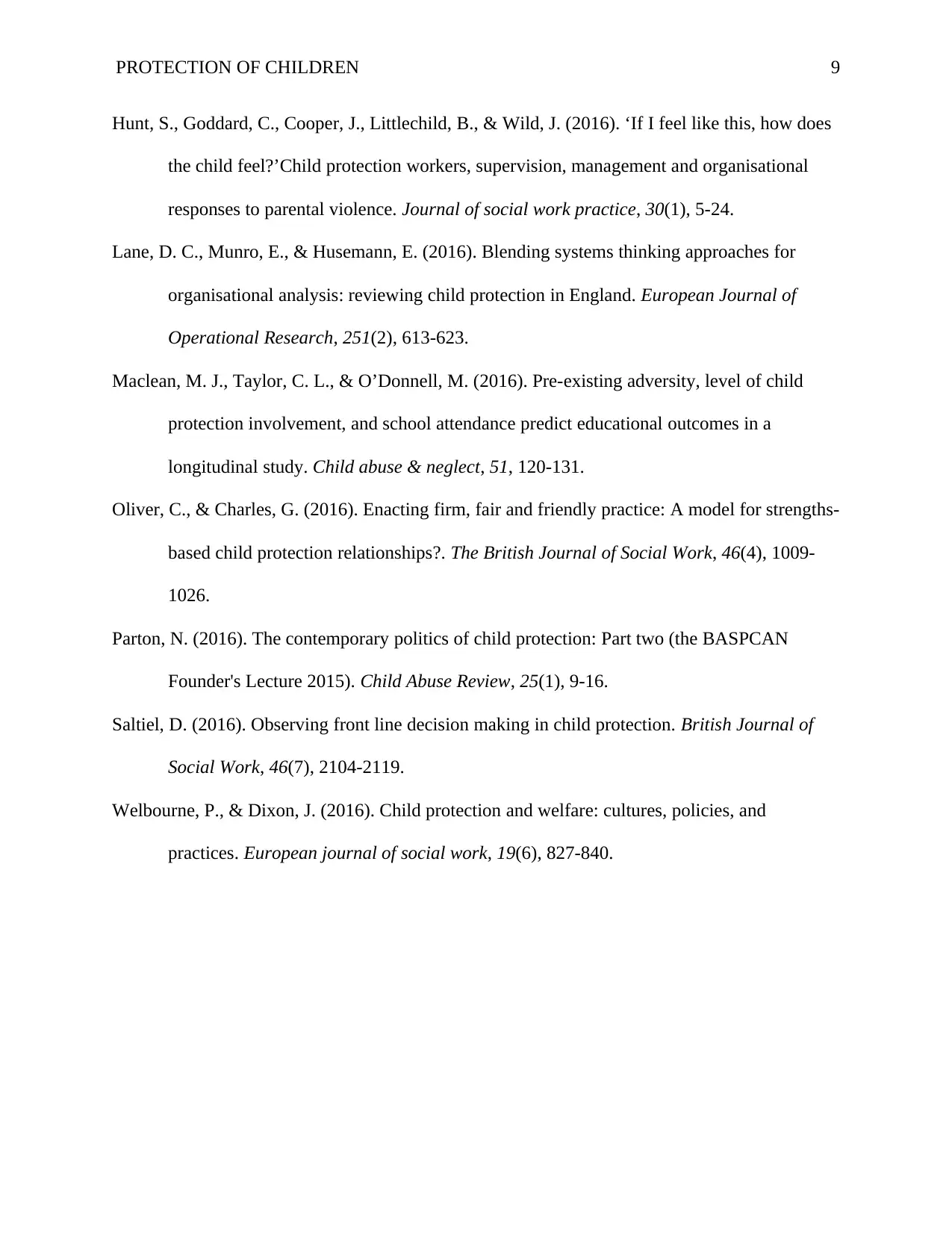
PROTECTION OF CHILDREN 9
Hunt, S., Goddard, C., Cooper, J., Littlechild, B., & Wild, J. (2016). ‘If I feel like this, how does
the child feel?’Child protection workers, supervision, management and organisational
responses to parental violence. Journal of social work practice, 30(1), 5-24.
Lane, D. C., Munro, E., & Husemann, E. (2016). Blending systems thinking approaches for
organisational analysis: reviewing child protection in England. European Journal of
Operational Research, 251(2), 613-623.
Maclean, M. J., Taylor, C. L., & O’Donnell, M. (2016). Pre-existing adversity, level of child
protection involvement, and school attendance predict educational outcomes in a
longitudinal study. Child abuse & neglect, 51, 120-131.
Oliver, C., & Charles, G. (2016). Enacting firm, fair and friendly practice: A model for strengths-
based child protection relationships?. The British Journal of Social Work, 46(4), 1009-
1026.
Parton, N. (2016). The contemporary politics of child protection: Part two (the BASPCAN
Founder's Lecture 2015). Child Abuse Review, 25(1), 9-16.
Saltiel, D. (2016). Observing front line decision making in child protection. British Journal of
Social Work, 46(7), 2104-2119.
Welbourne, P., & Dixon, J. (2016). Child protection and welfare: cultures, policies, and
practices. European journal of social work, 19(6), 827-840.
Hunt, S., Goddard, C., Cooper, J., Littlechild, B., & Wild, J. (2016). ‘If I feel like this, how does
the child feel?’Child protection workers, supervision, management and organisational
responses to parental violence. Journal of social work practice, 30(1), 5-24.
Lane, D. C., Munro, E., & Husemann, E. (2016). Blending systems thinking approaches for
organisational analysis: reviewing child protection in England. European Journal of
Operational Research, 251(2), 613-623.
Maclean, M. J., Taylor, C. L., & O’Donnell, M. (2016). Pre-existing adversity, level of child
protection involvement, and school attendance predict educational outcomes in a
longitudinal study. Child abuse & neglect, 51, 120-131.
Oliver, C., & Charles, G. (2016). Enacting firm, fair and friendly practice: A model for strengths-
based child protection relationships?. The British Journal of Social Work, 46(4), 1009-
1026.
Parton, N. (2016). The contemporary politics of child protection: Part two (the BASPCAN
Founder's Lecture 2015). Child Abuse Review, 25(1), 9-16.
Saltiel, D. (2016). Observing front line decision making in child protection. British Journal of
Social Work, 46(7), 2104-2119.
Welbourne, P., & Dixon, J. (2016). Child protection and welfare: cultures, policies, and
practices. European journal of social work, 19(6), 827-840.
⊘ This is a preview!⊘
Do you want full access?
Subscribe today to unlock all pages.

Trusted by 1+ million students worldwide
1 out of 9
Your All-in-One AI-Powered Toolkit for Academic Success.
+13062052269
info@desklib.com
Available 24*7 on WhatsApp / Email
![[object Object]](/_next/static/media/star-bottom.7253800d.svg)
Unlock your academic potential
Copyright © 2020–2025 A2Z Services. All Rights Reserved. Developed and managed by ZUCOL.

